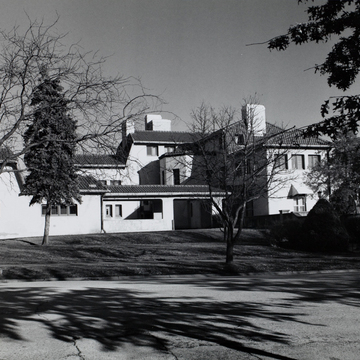Generally we associate the designs of the Chicago architect Barry Byrne with Frank Lloyd Wright and the Midwest Prairie school. But even Byrne's Prairie-style houses do not perfectly fit the mode, and much of his work after 1920 could be more aptly thought of as Expressionist. The Rich house is a fascinating design exercise. The principal garden facade has a two-story segmental curved portico with a gabled section above, which relates not to Chicago but to the turn-of-the-century Viennese Secessionists (particularly the work of Josef Hoffmann). Other sections of the Rich house, especially the tile roof ends which are treated as a sloped roof interrupted by recessed dormer windows, anticipate Byrne's Expressionist designs of the 1920s and later. The stucco walls, tile roofs, terrace walls, and roofed corridors convey a Mediterranean/ Hispanic feeling, but a close look shows that Byrne's reference to that tradition is slight. Corydon M. Rich, who engaged Byrne to design the house, was president of the American Rice and Cereal Company, and he built his new house on the site of an earlier extravaganza, the John Carl Hubinger “castle.” Although Rich transformed some of the earlier landscaping, including filling in an artificial lake created by Hubinger, he still was able to take advantage of the site's mature vegetation.
You are here
Rich House
If SAH Archipedia has been useful to you, please consider supporting it.
SAH Archipedia tells the story of the United States through its buildings, landscapes, and cities. This freely available resource empowers the public with authoritative knowledge that deepens their understanding and appreciation of the built environment. But the Society of Architectural Historians, which created SAH Archipedia with University of Virginia Press, needs your support to maintain the high-caliber research, writing, photography, cartography, editing, design, and programming that make SAH Archipedia a trusted online resource available to all who value the history of place, heritage tourism, and learning.





